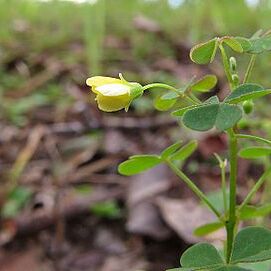Perennial herb with stems creeping or ascending, often rooting at nodes, to 35 cm long, very sparsely antrorse-hairy; taproot absent or poorly developed, rarely stout; bulb and bulbils absent. Indumentum of simple engladular hairs, occasionally with septate hairs on the capsules. Stipules to c. 2 mm long, conspicuous, with apex lobed or truncate, or inconspicuous with apex tapering abruptly to pedicel, ciliate. Leaves cauline, tufted, palmately trifoliolate; petiole 1–9 cm long, with antrorse hairs; leaflets sessile, cuneate-obcordate, (2.5–) 3.5–6 (–13) mm long, 3–10 (–16) mm wide, bilobed (sinus to c. one-third leaflet length), usually green, ± glabrous above, pubescent below, margins ciliate, lobes obovate, divergent, apices obtuse and 2–3 mm apart. Inflorescences axillary, flowers 1-or rarely 2 per peduncle, held ± at leaf level, or slightly above; peduncles at least as long as leaves, 7–40 mm long, glabrescent to densely antrorse-hairy; pedicels (4–) 8–25 mm long, erect or deflexed in fruit (but capsule erect). Bracts situated at base or at middle of pedicels, ± linear-subulate, 1–3 mm long, with ascending antrorse hairs, calli absent. Sepals oblong, 1.5–3 mm long, often ciliate. Petals oblong-obovate, 4.5–11 mm long, yellow, glabrous. Stamens at 2 levels; filaments glabrous. Ovary hairy. Styles 0.8–2.3 mm long, densely hairy. Capsules ovoid to conical to broadly cylindrical, (5–) 6–8 (–13) mm long, 2–3 mm diam., usually moderately retrorse-hairy, sometimes with longer, scattered, patent, septate hairs, seldom glabrescent or glabrous. Seeds (1.0–) 1.2–1.8 mm long, uniformly coloured, brown to dark brown, transversely ribbed, the ribs (4–) 6–10 (–13), narrow, without greyish or whitish lines or blotches (except in the variant from disturbed sites), the grooves V-shaped, narrow and deep.
More
Perennial; primary root slender to stout, occasionally to c. 10 mm thick. Stems glabrous to densely hairy (hairs usually antrorse, occasionally dense and patent), ± filiform, creeping, prostrate or nearly so, rooting at nodes, much-branched and often mat-forming. Lvs 3-foliolate. Petiole 5-40 mm long, with patent or antrorse hairs, these sparse to dense; stipules adnate, truncate or rounded at apex. Petiolules very short. Lamina of leaflets equal, 1-9 × 1.5-12 mm, obcordate, sometimes broadly so, with width > length, with narrow to broad sinus and rounded lobes, glabrous or hairy above, glabrate or with appressed hairs beneath, ciliate or eciliate, often purplish below; calli 0. Fls solitary, rarely paired; peduncle glabrate to densely clothed in antrorse hairs, generally geniculate at apex; pedicel (4)-8-25 mm long. Bracts 1-3 mm long, ± linear-subulate, hairy, situated at base or at middle of pedicels; calli 0. Sepals 2.3-3.5-(4) mm long, oblong-lanceolate, oblong, or ovate-elliptic, glabrate or with antrorse hairs; calli 0. Petals 4.5-9-(13) mm long, ± oblong-obovate, yellow, often pink-flushed outside, glabrous. Stamens at 2 levels, glabrous or nearly so; filaments united at base, those of longer whorl c. 1.5 mm long. Styles < or > longer stamens, densely hairy. Capsule (3)-7-10-(13) mm long excluding styles, broadly cylindric, cylindric-ovoid or conic, glabrous to densely hairy; hairs short, patent or retrorse, sometimes glandular. Seed 1-1.3-(1.5) mm long, broad-ellipsoid; transverse ridges 7-13, subacute, sometimes white-topped; grooves deep.

